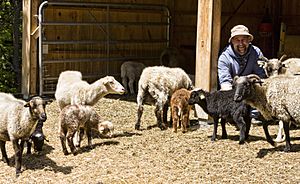Navajo-Churro facts for kids

A Navajo-Churro ram
|
|
| Conservation status | Threatened |
|---|---|
| Other names | American Four-Horned Sheep, Navajo Four-Horned Sheep |
| Country of origin | United States |
|
|
The Navajo-Churro, or Churro for short, is a special type of domestic sheep. It's also known as the American or Navajo Four-Horned sheep. These sheep came from Spanish Churra sheep around the 1500s. Native American groups like the Navajo and Hopi got them during the Spanish Conquest.
This breed is famous for being very tough. They can live well in many different climates, even very hot or cold ones. Their wool has two layers: a strong outer coat and a soft inner coat. Some male Navajo-Churro sheep, called rams, can even have four fully grown horns! This is a rare trait shared by only a few other sheep breeds.
Navajo-Churro sheep are also popular because they are easy to care for. They don't get sick easily and their meat is lean. Many people say they are very friendly. Female sheep, called ewes, often give birth to twin lambs. These sheep are mainly raised for their valuable wool.
Contents
The Churra sheep first arrived in North America in the 1500s. Spanish armies and settlers used them for food. By the 1600s, Churros were very popular with Spanish settlers in the Rio Grande Valley. The Navajo people also got flocks of Churros through trading. Soon, the Churro sheep became a very important part of the Navajo way of life and their economy.
Later, the United States government started programs that greatly reduced the number of Navajo flocks. They also encouraged cross-breeding with other sheep. This caused the Churro sheep to almost disappear. But in the 1970s, people began working to save the breed. They found Churro sheep that still had the original traits. Their goal was to bring back the breed and help Navajo and Hispanic flocks grow again.
Today, the Navajo-Churro breed is no longer in danger of disappearing completely. However, it is still considered a rare type of sheep.
Navajo-Churro rams can have two, four, six, or even more horns! This is because they have a special gene called the polycerate gene. This gene is also found in old sheep breeds like the Jacob sheep. Sometimes, their horns can even grow together, or "fuse."
Female sheep, or ewes, can also have horns. Sometimes they have small bumps called scurs instead of full horns. The horns can be black, white, or striped. Rams' horns grow slowly, taking about four to five years to become fully grown. Ewes' horns can also get large, but not as big as the rams'.
The quality of a ram's horns is important for good genetics in a flock. If a father sheep has poor horns, his babies might too. Horns can break, and since they are living at the base, they will bleed if they break.
Churro sheep come in many different colors. You can find them in reds, browns, black, white, and mixed colors. Their color can even change as they get older. The color of their wool, called the fleece, is different from the color of their "points" (their legs and head). These sheep can also have different patterns, like patches around their eyes or spots on their hips.
Navajo-Churro sheep have a special double coat of wool. It has an inner layer and an outer layer. The fleece is mostly made of the soft inner coat (about 80%). The outer coat has tougher hair fibers (10-20%) and a coarse, stiff fiber called kemp (less than 5%).
The color of the fleece is separate from the color of the sheep's legs and head. The fleece color can often change from when they are lambs to when they are grown up. For example, black lambs often become whiter as they age.
The Navajo people have used Churro fleece for a long time to make beautiful rugs and other woven items. The many natural colors of the fleece make it easy to create colorful designs without needing to dye the wool. However, natural plant dyes are sometimes used to make deeper colors or more choices.
Conservation Status
The Navajo-Churro sheep are listed as "threatened" by The Livestock Conservancy. This means their numbers are still low, and efforts are being made to protect them. They are also part of the Slow Food Ark of Taste, which helps preserve special heritage foods and breeds.
See also
 In Spanish: Navajo churro para niños
In Spanish: Navajo churro para niños


